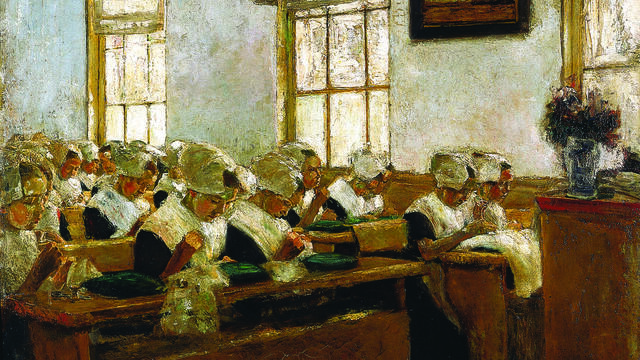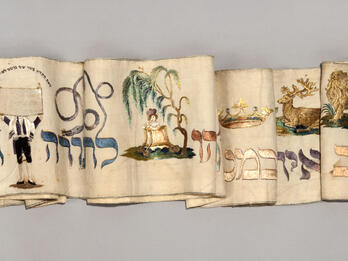Painters, Sculptors, and Photographers, 1750–1880
All over the world, Jewish art reflected the hybrid nature of Jewishness, including the material circumstances and cultural milieu of the larger environment. Individual artisans and artists selected and created according to their personal and Jewish experiences.

“Jewish Art” or Art by Jews?
For the longest time, scholars of the visual arts and built environment discounted the very notion of Jewish fine art, not to mention architecture. “Jewish art” conjured primarily objects intended for ritual purposes. The material included in the Posen Library embraces the ever-growing body of scholarship that demonstrates that contrary to earlier assumptions, Jews pursued artistic expression in many media wherever they lived. As new gateways to artistic education and freedom opened, Jews flocked to the arts and made them their own. All over the world, Jewish art reflected the hybrid nature of Jewishness, including the material circumstances and cultural milieu of the larger environment. Individual artisans and artists selected and created according to their personal and Jewish experiences.
The pursuit and nurturing of the fine arts (primarily painting and sculpture) required elaborate educational, social, economic, and institutional frameworks. This context scarcely existed for Jews until the later decades of the nineteenth century (although the myth that Jewish culture shunned visual expression has long been put to rest). Unlike music, to which Jews had at least some basic approach in synagogue settings, no framework in premodern society existed within which Jews could pursue the fine arts. The emergence of Jews as painters and sculptors involved more of a creation de novo than any of the other fields of culture in which Jews participated. Visual artists included painters, sculptors, photographers, engravers of medals and coins, miniaturists, and muralists. It is difficult to name even one serious sculptor of Jewish origins who worked before the nineteenth century, and although Jews had been making craft items of exquisite beauty through the ages, other than synagogue decoration, manuscript illustration, and metal engraving, it is difficult to find them painting and drawing much earlier than this period.
To speak of the opening of the world to art made by Jews and the opening of Jewish eyes to the world of art, a new framework as well as a new mind-set had to come into being on both sides. Fine arts required access into social circles that cultivated and appreciated secular art. Gradual exposure of more Jews to more Western art meant that more of them were able to contemplate and appreciate it. Academies and circles of painters where art could be studied and learned began to accept Jewish students. Salons at which art could be exhibited and analyzed, homes in which it could be commissioned and hung, and museums that could acquire, display, and validate it, each of these formed a necessary link for the cycle of artistic affirmation to be perpetuated. To earn a livelihood, artists needed to cultivate the commercial side of art, to befriend agents and dealers who would introduce them to the parts of society that could afford to cultivate their talent. Art could be criticized in journals, replicated in print for popular consumption, and collected for private and public appreciation. As the nineteenth century progressed, Jews moved from the margins to the center of the art world, both as creators of first-rank art and as entrepreneurs.
Yet a label such as “Jewish art” is neither helpful nor relevant. Certainly, there is nothing inherently Jewish about many of the images included in the Posen Library, and users may be surprised by some of the choices. The guiding principle for inclusion has been the identity of the artist (with the exception of certain portraits), based on the concept that art expresses the experience and personality of the artist, even if that connection is not immediately obvious. The artists exhibited the world they knew best, in all its particularity, as a subject just as worthy of artistic depiction as any other.
While histories of Jews and the fine arts often survey the national or stylistic clusters of artists, this tends to obscure some of the remarkable commonalities that many of the Jewish artists shared. The number of family members who shared some roots or orientation in cognate fields is striking. Three brothers of the Dutch Verveer family became renowned artists. Salamon Leonardus Verveer and his brother Elchanon Leonardus Verveer were famed for iconic depictions of the Dutch landscape. A third brother, Maurits, was a skillful painter as well; by the mid-1850s he had turned to photography, one of the first in the Netherlands to do so. Henschel, Solomon, Meyerbeer (Beer), and Weiner represent just a few of the family clusters of Jewish artists productive in this period.
Every one of the selections included in the Posen Library from this period represents a personal, and Jewish, odyssey. In some cases, this is addressed overtly in the works of art themselves, whereas in many others, the artist or his or her work did not represent conventional Jewishness or Jewish identity. The very ordinariness of some of these images and their lack of any particularly Jewish content reflects ways in which the artist embraced the world. In other cases, the work is deeply Jewish in theme and here the general message is the reverse. The artist is exhibiting the world he or she knows best, in all its particularity, as a subject just as worthy of artistic depiction as any other.
Jews as Patrons of the Arts
Jews served the art world as prominent and influential critics, patrons, collectors, and exhibitors of the arts. They collected, displayed, and donated art to eminent institutions. Jews used their collections to announce their aesthetic discernment and financial success. Thus, Lesser Gieldzinski (1830–1910) collected furniture, paintings, and Judaica, objects that collectively affirmed his Jewish identity as well as his citizenship and rootedness in the city of Danzig. Isaac Straus of Strasbourg exhibited (perhaps for the first time in modern history) his collection of Jewish ceremonial objects at the Palais de Trocadéro in Paris in 1878. The exhibit marked a new turn toward the nostalgic appreciation of explicitly Jewish art, a turn that was not fully realized until the end of the nineteenth century. The Rothschild, Sassoon, and Goldsmid families began to amass collections that became synonymous with Jewish art collecting. Their donation of collections to central institutions to exhibit under their names in perpetuity expressed their desire to be remembered in association with the features of the art they collected.
Although most of these collections did not focus primarily on Jewish art, by the late nineteenth century many European Jews regarded artistically crafted Jewish ceremonial objects with a new gaze, as exotic reminders of a lost past. By then, European interest in the art and archeology of ancient Palestine demonstrated to the world that the modern emergence of Jews in the art world was no anomaly but rather the recovery of a lost patrimony.
As creators, but also as patrons, collectors, commissioners, critics, and popularizers of the visual arts, Jews made significant and notable contributions to the arts and to their appreciation in the emerging public spheres.
Jews and Early Photography
As a new technology, photography caught the imagination of young Jews. Louis Daguerre invented his eponymous process using chemicals to capture an image on a silver plate in 1839, and within a few years the technique had spread through Europe and the United States. Initially used for portraiture, one of the first to employ the technology to capture the great outdoors was Solomon Nunes Carvalho. Carvalho accompanied explorer John Fremont on an expedition across the United States in 1853. Despite the demanding challenges of the process itself, not to mention the need to adapt it to freezing conditions, they captured some three hundred daguerreotype images, a historic achievement. This traditional Jew of Sephardic descent penned a riveting and best-selling account of his adventures. Through his images and his account of their expedition, Incidents of Travel and Adventure in the Far West, Carvalho became the lens through which many Americans first encountered the western frontier, its magnificent and rugged landscapes, and its Native Americans.



